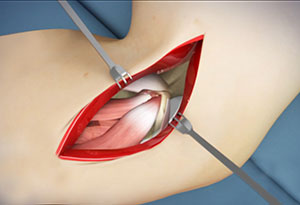
What is Open Elbow Surgery?
Open elbow surgery is an operative procedure performed to treat certain conditions of your elbow through an open cut (incision) in the skin using a scalpel.
It is a type of surgery where fatty tissues and muscle layers of the elbow beneath the skin are cut to expose the entire operative area. This will help your surgeon to have a full view of the affected structures involved.
Conditions Treated by Open Elbow Surgery
Open elbow surgery is done to treat several conditions of the elbow. They include but are not limited to:
- Tennis elbow - painful swelling and inflammation of the joint caused by overuse
- Trauma such as open fractures, displaced fractures, bone dislocations
- Cubital tunnel syndrome - compression of the ulnar nerve crossing the elbow
- Radial tunnel syndrome - increased pressure on the radial nerve at the elbow joint
- Osteoarthritis - degeneration of the joint cartilage due to age and activity
Candidates for the Surgery
The surgery is typically recommended for those who are:
- Incapacitated by a condition of the elbow
- Not benefiting from conservative treatments
Preparation
Your surgeon will advise you on the following prior to the surgery:
- Stop taking medicines (if any) that could cause bleeding during the procedure
- Avoid food or drink of any sort after midnight the night before the surgery
- Quit smoking (if applicable) as it can slow healing and recovery from the surgery
- Arrange for someone to drive you back home after the surgery
Open Elbow Surgery Procedure
Just before the surgery, a sterile drape is placed around the operative site after which you will be administered general anesthesia or a sedative to help you relax and make you sleepy. Numbing medicine may also be given to your arm to block pain all through the procedure.
The skin around the operative area where the incision will be made is scrubbed thoroughly and an antiseptic solution is applied.
During the surgery, an incision is made in the skin just above the bone over the outside of your elbow or at the side of the elbow to access the affected area.
Depending on the type of condition being treated, your surgeon will carry out the following:
Tennis elbow
The location of the tendon damage is identified and treated by way of any of the below methods:
- The damaged portion is released by severing its connection to the bone.
- The damaged portion is repaired using a suture anchored into the bone or by stitching it to other tendons.
- The damaged part is cut out and the healthy portion is reattached back to the bone.
- The underlying bone is exposed and a tiny piece of it is removed to stimulate blood flow and help the area heal faster.
Trauma (Fractures)
Broken bones are repositioned into their original place and surgically fixed with hardware such as plates, screws and/or pins.
Cubital or radial tunnel syndrome
The tissue covering the ulnar nerve or radial nerve is cut to relieve the compression or pressure on that nerve.
Osteoarthritis
The damaged parts of the joint are identified and replaced with artificial joints.
Regardless of the condition treated, the incision is closed with stitches or staples, and a sterile dressing is applied. The arm may be placed in a splint.
Risks Associated with Open Elbow Surgery
As with any surgery, the procedure can lead to possible complications such as:
- Severe pain, redness and infection in the elbow
- Injury to the nerves or blood vessels in the elbow
- Swelling in the elbow that does not go away
- Skin color changes and scar formation around the elbow
- A feeling of reduced strength and loss of flexibility
- The requirement of a second procedure
After Surgery Care
After surgery, be careful not to injure your elbow. You may need to wear a splint to keep your arm still or immobilized. You are also advised to keep the wound and the dressing clean and dry.
Related Topics
- Open Elbow Surgery
- Distal Biceps Repair
- ORIF of the Humerus Fractures
- Radial Head ORIF and Replacement
- Common Extensor Tendon Origin Repair
- Total Elbow Replacement
- Elbow Arthroscopy
- ORIF of the Coronoid Fractures
- Elbow Ligament Reconstruction
- Elbow Tendon and Ligament Repair
- UCL Reconstruction (Tommy John Surgery)
- Tennis Elbow Surgery
- Ulnar Nerve Release
- Ulnar Nerve Transposition
- ORIF of the Distal Humerus Fractures
- ORIF of the Olecranon Fractures
- Ulnar Collateral Ligament (UCL) Repair with Internal Brace





